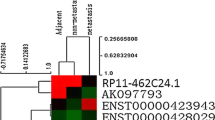Abstract
Colorectal cancer is the main cause of human death due to cancer. This fact could be due to the insufficiency of early diagnosis or poor therapeutic strategies. Various molecular tools have been utilized in studies to assess their potentials as diagnostic biomarkers or determining factors in precision medicine. Among these molecules, long non-coding RNAs (lncRNA) have been emerging as accurate and potent transcripts to improve the detection of cancer. The overexpressed lncRNAs could also be deeply studied as the molecules for the targeted therapy in different malignancies, in particular colorectal cancer. Thus, we utilized an unbiased approach to select the up-regulated lncRNAs in colon adenocarcinoma via analyzing the TCGA dataset. Then, we validated the overexpression of two first-ranked lncRNAs, i.e., NPSR1-AS1 and TLX1NB, in our in-house colorectal cancer samples as compared to the paired adjacent normal tissues. The analyses revealed that these lncRNAs could significantly distinguish the tumor against the normal samples. The results may have implications in the early diagnosis and targeted therapy of colorectal cancer.




Similar content being viewed by others

References
Siegel RL, Miller KD, Goding Sauer A, Fedewa SA, Butterly LF, Anderson JC, et al. Colorectal cancer statistics. CA Cancer J Clin. 2020;70(3):145–64.
Malih S, Saidijam M, Malih N. A brief review on long noncoding RNAs: a new paradigm in breast cancer pathogenesis, diagnosis and therapy. Tumor Biol. 2016;37(2):1479–85.
Tabatabaeian H, Peiling Yang S, Tay Y. Non-coding RNAs: uncharted mediators of thyroid cancer pathogenesis. Cancers. 2020;12(11):3264.
Fattahi S, Kosari-Monfared M, Golpour M, Emami Z, Ghasemiyan M, Nouri M, et al. LncRNAs as potential diagnostic and prognostic biomarkers in gastric cancer: a novel approach to personalized medicine. J Cell Physiol. 2020;235(4):3189–206.
Dastmalchi N, Safaralizadeh R, Nargesi MM. LncRNAs: potential novel prognostic and diagnostic biomarkers in colorectal cancer. Curr Med Chem. 2020;27(30):5067–77.
Xu W, Zhou G, Wang H, Liu Y, Chen B, Chen W, et al. Circulating lncRNA SNHG11 as a novel biomarker for early diagnosis and prognosis of colorectal cancer. Int J Cancer. 2020;146(10):2901–12.
Shen X, Xue Y, Cong H, Wang X, Fan Z, Cui X, et al. Circulating lncRNA DANCR as a potential auxillary biomarker for the diagnosis and prognostic prediction of colorectal cancer. Biosci Reports. 2020;40(3):BSR20191481.
Wang F, Ni H, Sun F, Li M, Chen L. Overexpression of lncRNA AFAP1-AS1 correlates with poor prognosis and promotes tumorigenesis in colorectal cancer. Biomed Pharmacother. 2016;81:152–9.
Wang J, Xu C, Wu H, Shen S. LncRNA SNHG12 promotes cell growth and inhibits cell apoptosis in colorectal cancer cells. Braz J Med Biol Res. 2017;50(3): e6079.
Li J-H, Liu S, Zhou H, Qu L-H, Yang J-H. starBase v20: decoding miRNA-ceRNA, miRNA-ncRNA and protein–RNA interaction networks from large-scale CLIP-Seq data. Nucl Acids Res. 2014;42(D1):D92–7.
Wu H-C, Chang D-K, Huang C-T. Targeted therapy for cancer. J Cancer Mol. 2006;2(2):57–66.
Smith KN, Miller SC, Varani G, Calabrese JM, Magnuson T. Multimodal long noncoding RNA interaction networks: control panels for cell fate specification. Genetics. 2019;213(4):1093–110.
Liang C, Zhao T, Li H, He F, Zhao X, Zhang Y, et al. Long non-coding RNA ITIH4-AS1 accelerates the proliferation and metastasis of colorectal cancer by activating JAK/STAT3 signaling. Mol Therapy Nucl Acids. 2019;18:183–93.
Shigeyasu K, Okugawa Y, Toden S, Miyoshi J, Toiyama Y, Nagasaka T, et al. AZIN1 RNA editing confers cancer stemness and enhances oncogenic potential in colorectal cancer. JCI Insight. 2018;3(12): e99976.
Blanco FF, Preet R, Aguado A, Vishwakarma V, Stevens LE, Vyas A, et al. Impact of HuR inhibition by the small molecule MS-444 on colorectal cancer cell tumorigenesis. Oncotarget. 2016;7(45):74043.
Liu Y, Chen X, Cheng R, Yang F, Yu M, Wang C, et al. The Jun/miR-22/HuR regulatory axis contributes to tumourigenesis in colorectal cancer. Mol Cancer. 2018;17(1):1–15.
Cai J, Wang H, Jiao X, Huang R, Qin Q, Zhang J, et al. The RNA-binding protein HuR confers oxaliplatin resistance of colorectal cancer by upregulating CDC6. Mol Cancer Ther. 2019;18(7):1243–54.
Binefa G, Rodríguez-Moranta F, Teule À, Medina-Hayas M. Colorectal cancer: from prevention to personalized medicine. World J Gastroenterol: WJG. 2014;20(22):6786.
Diamandis M, White NM, Yousef GM. Personalized medicine: marking a new epoch in cancer patient management. Mol Cancer Res. 2010;8(9):1175–87.
Quan J, Pan X, Zhao L, Li Z, Dai K, Yan F, et al. LncRNA as a diagnostic and prognostic biomarker in bladder cancer: a systematic review and meta-analysis. Onco Targets Ther. 2018;11:6415.
Galamb O, Barták BK, Kalmár A, Nagy ZB, Szigeti KA, Tulassay Z, et al. Diagnostic and prognostic potential of tissue and circulating long non-coding RNAs in colorectal tumors. World J Gastroenterol. 2019;25(34):5026.
Mashhadizadeh S, Tavangar M, Javani AF, Rahimian MD, Azadeh M, Tabatabaeian H, et al. PGR and TUG1 overexpression: a putative diagnostic biomarker in breast cancer patients. Gene Rep. 2020;21:100791.
Acknowledgements
We would like to appreciate the tissue donors for this study.
Funding
Not applicable.
Author information
Authors and Affiliations
Corresponding author
Ethics declarations
Conflict of interest
All authors declare that they have no conflict of interest.
Research involving human participants and/or animals
All the samples were collected in accordance with the guidelines issued by the Ethics Committee of Isfahan University of Medical Sciences (approval number: 6593769), regarding the 64th World Medical Association General Assembly of Helsinki declaration amended in October 2013.
Informed consent
The informed consent was taken from all the patients who participated in this study.
Additional information
Publisher's Note
Springer Nature remains neutral with regard to jurisdictional claims in published maps and institutional affiliations.
Rights and permissions
About this article
Cite this article
Dastjerdi, S., Valizadeh, M., Nemati, R. et al. Highly expressed TLX1NB and NPSR1-AS1 lncRNAs could serve as diagnostic tools in colorectal cancer. Human Cell 34, 1765–1774 (2021). https://doi.org/10.1007/s13577-021-00597-x
Received:
Accepted:
Published:
Issue Date:
DOI: https://doi.org/10.1007/s13577-021-00597-x



